This is the second in a two-part blog series that explores the intersection of art and environmental protection with interviews featuring the 2020 visiting artists for Baxter State Park and the Allagash Wilderness Waterway. Read our interview with Baxter visiting artist Jill Osgood.
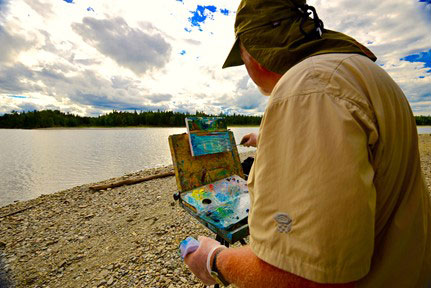
Photo by Troy Sands
This year the Bureau of Parks and Lands introduced a new artist in residence program for the Allagash Wilderness Waterway. The Natural Resources Council of Maine was thrilled to be able to speak with Michael E. Vermette of Old Town who was selected as the inaugural visiting artist about his experience. Michael is an award-winning oil and watercolor painter and Maine Certified Art Instructor. He spent two weeks in August living at the Lock Dam Camp and creating artwork that captures the wild beauty of the Waterway.
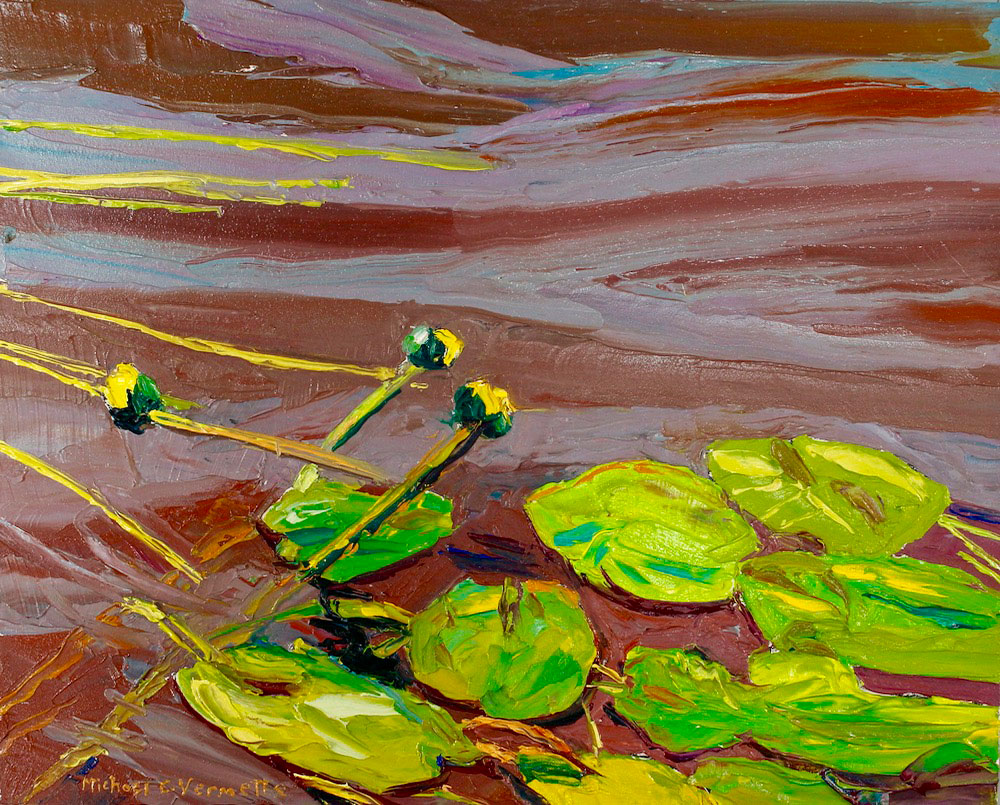
“Water Lilies of Chamberlain Lake” by Michael Vermette
Tell us a little about yourself and your art. What prompted you to pursue this path? What is it about art that captures you? Was there a particular moment when you realized you had a gift?
Plein air painting for me is a captivating secret place where you meet your Creator on the page, panel, or canvas in order to co-create beauty together. In the natural setting, painting en plein air becomes the metaphor for an even deeper truth when the artist stays open to nature, fully engaged and painting with both hands on the present.
Ever since I can remember I made drawings and was artistic. My talent compensated for my dyslexia that made me struggle in my education. All throughout my life art became the thing I was good at. My family, teachers, and community always made room for my creative ability.
But it wasn’t until I received a spiritual encounter at 17 years old that I knew that this talent I had was to be more than a coping skill to achieve success. This calling came to me on Monhegan Island when my mother invited me to go on a day trip with her. I walked away from that Island experience with purpose and an urgency to attend the Maine College of Art (MECA).
I graduated from MECA and went on to receive my Maine teacher certification in K-12 Art Education through the University of Maine at Orono. I have taught art part-time for 34 years for Maine Indian Education.
Since then I have returned to wild places each year as a former artist fellow of the Monhegan Residency Program, and other residencies such as Baxter State Park, twice at Acadia National Park, the AMC Highland Center at Crawford Notch in New Hampshire, and now the Allagash Wilderness Waterway.
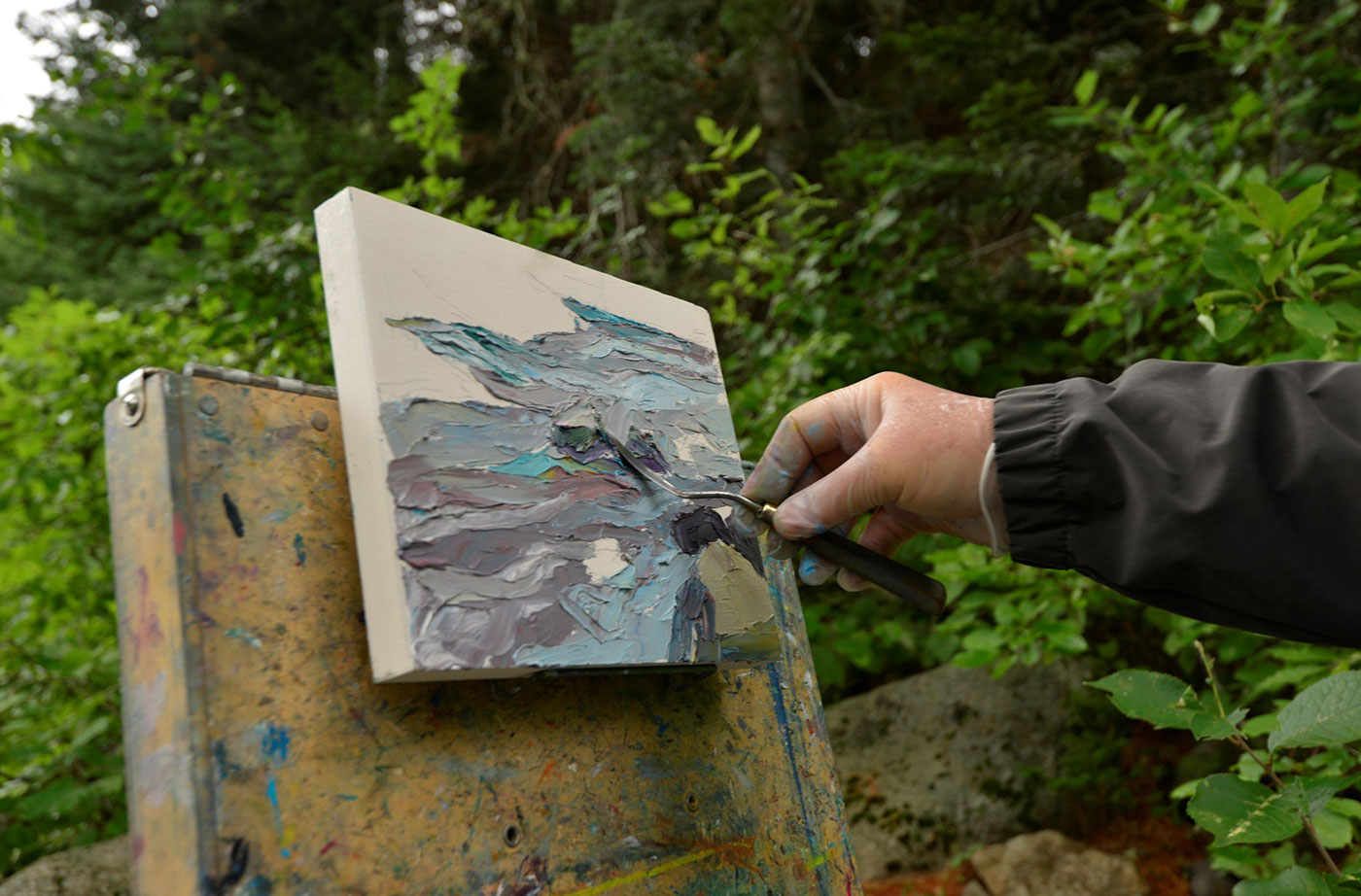
Photo by Troy Sands
What was it about the Allagash Wilderness Waterway Visiting Artist Program that intrigued you? Was it what you expected? Were there particular challenges and rewards?
What intrugued me the most was the opportunity to retreat two weeks in the most remote and wild preservation water route in Maine.
The residency program went far beyond what I expected in many ways. There are always challenges when faced with plein air painting in the wild. The biggest challenge for me was planning what to paint in the 92-mile-long protected area. What made it easier for me was the fact that I was studio-based out of Milford and Dot Kidney’s amazing cabin at Lock Dam, which is located on Chamberlain Lake in the southern region of the Allagash Wilderness Waterway. There were plenty of subjects to keep me painting. The biggest benefit I experienced time and again was the privilege of being in the right location at the right time to capture the beauty that make people return each year to their favorite campsite.
I knew that part of the residency was the requirement to hold a workshop and open studio. It had been a lifelong goal of mine to hold a plein air watercolor workshop at one of the historical sporting camps. Thanks to the efforts of Superintendant Matt LaRoche, park rangers, and the Thornton Family who are the owners of Nugent’s Camps, I was ultimately able to hold the first plein air watercolor workshop on Chamberlain Lake in the Allagash Wilderness Waterway. It was a very productive workshop of eight participants who painted about 40 or more studies that day.
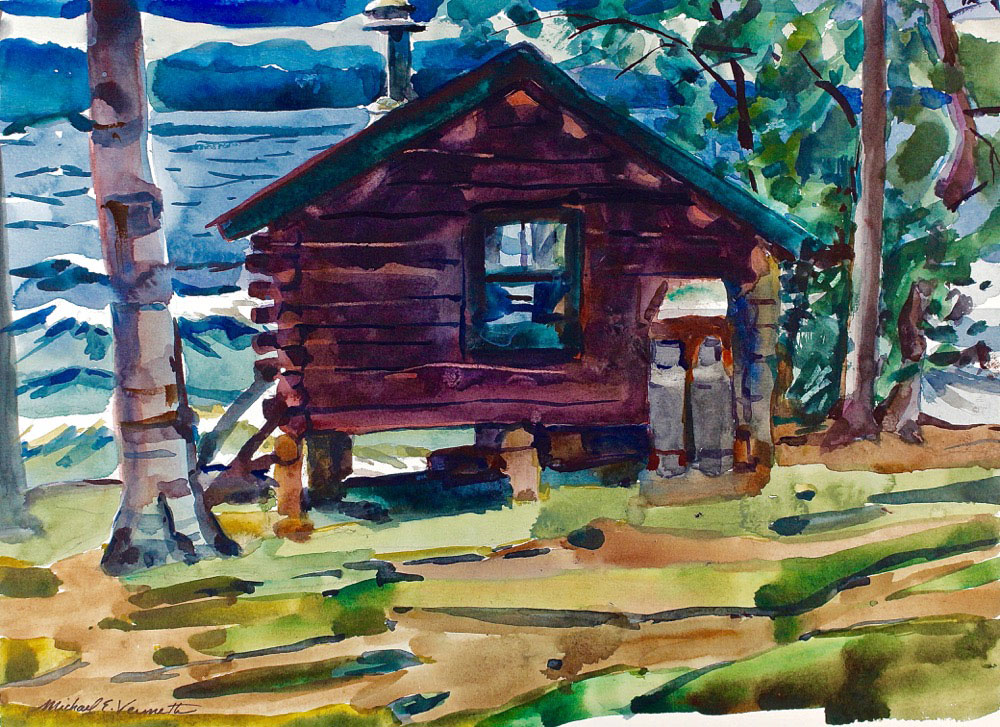
“Shore Cabin at Nugent’s Camp” by Michael Vermette
Where did you go along the Waterway? Any favorite spots?
I painted 51 studies of 51 different locations within a two-hour block of time for each painting. That was because the light changes every two hours, and I wanted to capture the atmosphere in that moment of time.
I mostly painted the southern regions of the Allagash Wilderness Waterway closest to Lock Dam on Chamberlain Lake. My three favorite locations were the views I painted at the summit of Allagash Mountain, Bear Mountain from Philsbury Island (where Henry David Thoreau’s campsite was located), and the large oil painting on a 38 x 48-inch linen that I am currently working on in my studio, from a study and photographs of superintendent Matt LaRoche and ranger Bob Johnston shooting Chase Rapids.
Did you have any encounters with wildlife?
My first morning at Lock Dam I got up at 5:00 a.m. to capture the sunrise at the end of the portage at Martin Cove on Eagle Lake. Just as I reached the portage area I saw a bull moose and a cow across the cove about 25 yards away from me. The bull moose had a full velvety rack and was staring right at me. We both froze while the cow looked around to try and see what was up. I studied them for quite a while.
I also experienced daily all kinds of birds. An eagle perched on a tree that took flight when portaging. A deer came up onto the lawn of Lock Dam cabin while I was painting. A blue heron flew right toward me until it was aware I was there, then veered off at the last minute, and a family of squirrrels kept me awake on more than one night in the attic, dropping small apples they collected from the apple tree in the backyard.
My scariest moment was a warning I received from a black bear after returning from the outhouse in the dark just before dawn. Lock Dam cabin is located right in the middle of a thoroughfare that connects Chamberlain Lake to Eagle Lake, and animals migrate freely between the two lakes all the time.
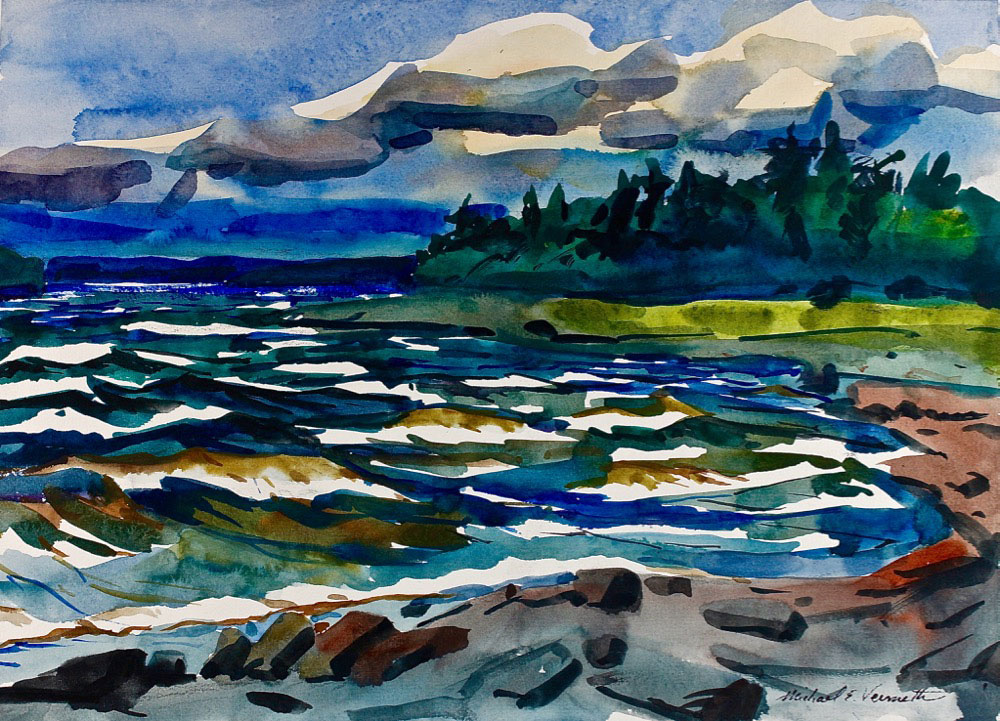
“Rough Waters on Chamberlain Lake from Lock Dam” by Michael Vermette
Were there any experiences during your time at the Waterway that were particularly inspiring for your artwork?
The most inspirational practice that kept me grounded in my work at the Allagash Wilderness Waterway was my painting routine. I actually committed to “The Race” that the famous artist-teacher Robert Henri conducted with his students on Monhegan Island in the 1950s. He made a gentleman’s bet that challenged his students to paint as many studies as they could paint in a day. As a result, some of the most beautiful studies were executed in the weeks that ensued by George Bellows, Randall Davey, and Robert Henri. It was legendary.
My race in the Allagash included four principles to which I committed. The first step was that I would try to have enough vision to see the end in sight. From my painting supplies and planning my meals right down to the gas I used to power my boat motor and truck, I planned it all around the goal of painting 50 studies in just two weeks.
Secondly, I would make up my mind to focus on the “joy” of the painting process. There were many distractions that included bugs, weather, animals, injuries, getting lost, and even expectations from people that can make you second guess why you’re there in the first place. But my decision to trade all of that for the joy I felt while painting actually pulled me through. It was a creative painting process that lived in the moment where pure ideas are born.
Thirdly, I would let go of the past and the future to focus on painting in the present. You can’t make this many painted studies with a hand on past works or future works. You must focus with two hands always on the present.
Lastly, I would press on by listening to my heart instead of my feelings, especially if I hit a wall or became physically tired. The greatest plein air paintings touch something inside because of the careful attention to principles demonstrated by the artist to quality, uniqueness of the idea, and a genuine heartfelt encounter with the subject. Painting one study after another is a wonderful rhythm to be engaged in with nature, especially in a remote and wild place like the Allagash Wilderness Waterway.
How do you think your experience will shape you and your work going forward?
The 51 painted studies painted at the Allagash Wilderness Waterway en plein air represent the first phase of my residency. That was a time for collecting painting ideas and experiences.
The second phase is to bring these works back into my studio, review them, and use the studies to make larger works in the studio throughout the year and right up to the time another artist will take my place for next year. My thought is to make 14 large paintings, representing each of the days I was there, in addition to the 51 studies. I will combine the study of the present landscapes with the fleeting moment of photography to create paintings where the subject is portrayed at its best. By using the photograph instead of copying it and combining the study, I am excited to create what I originally experienced in those subjects that happened in a moment of time. And that is always intriguing to me.
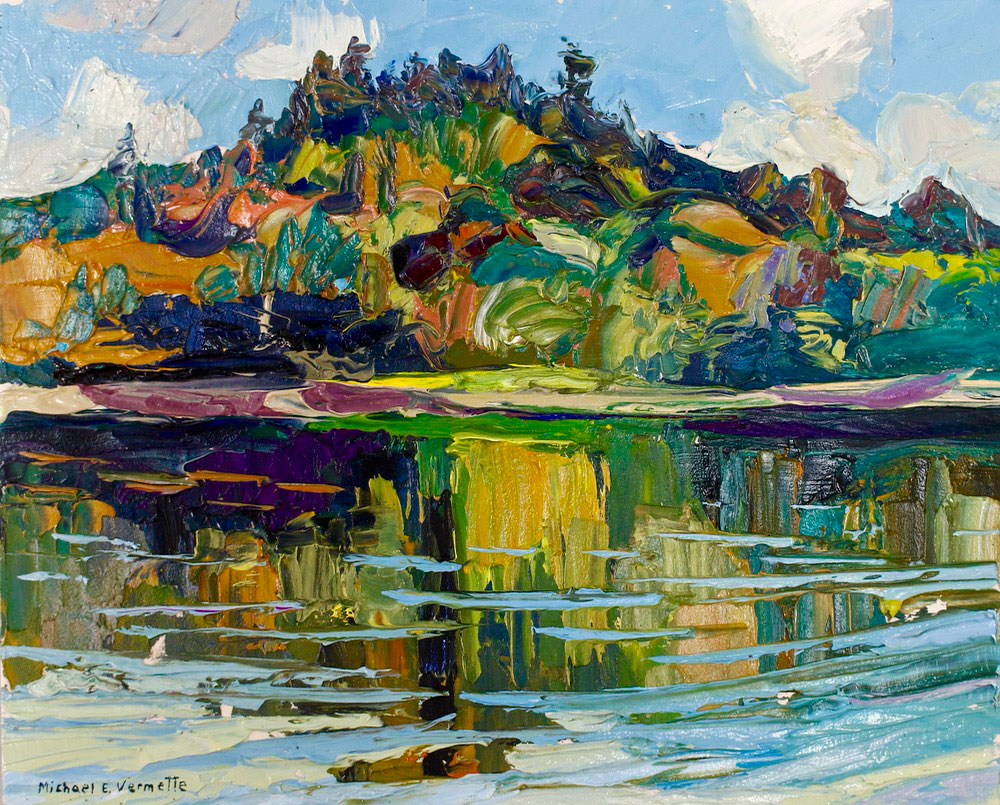
“Bear Mountain from Philsbury Island, Eagle Lake, Allagash,” by Michael Vermette
Where can folks see the artwork you created at the Allagash?
There are two galleries that have expressed an interest in featuring the show in the spring of 2021. The dates are not yet set. They are the Gleason Fine Art Gallery in Boothbay Harbor and Yarmouth Frame and Gallery in Yarmouth.
The show will be called “50 Plus One” and will be an exhibit of the 50 studies and 14 paintings combined to commemorate the 50th anniversary of the federal designation of the Allagash as a “wild and scenic river” plus one to make a one-person show. I am also working on writing a catalogue book that will go along with the exhibit.
I’d like to thank Superintendent Matt Laroche, and his rangers Kevin Brown, Chief Ranger; Ben Hall, Assistant Ranger; Ranger Bob Johnston; Ranger Jay Young; and Assistant Ranger Alissa Lutz for helping to make my stay a productive and perfectly enjoyable wilderness experience. I would also like to thank all my supporters and sponsors, including Old Town Canoe, my patrons Adrianne Piewonski and Paul Girdis, and the galleries that support my artistic vision. And also my wife Elaine and family who are my closest spiritual support. You guys all rock!
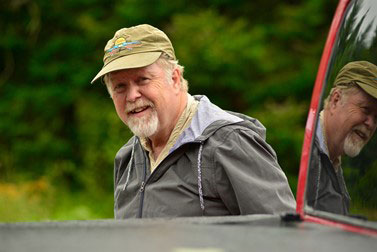
Michael Vermette
Learn more about Michael and his work at https://www.michaelevermette.com.










Leave a Reply